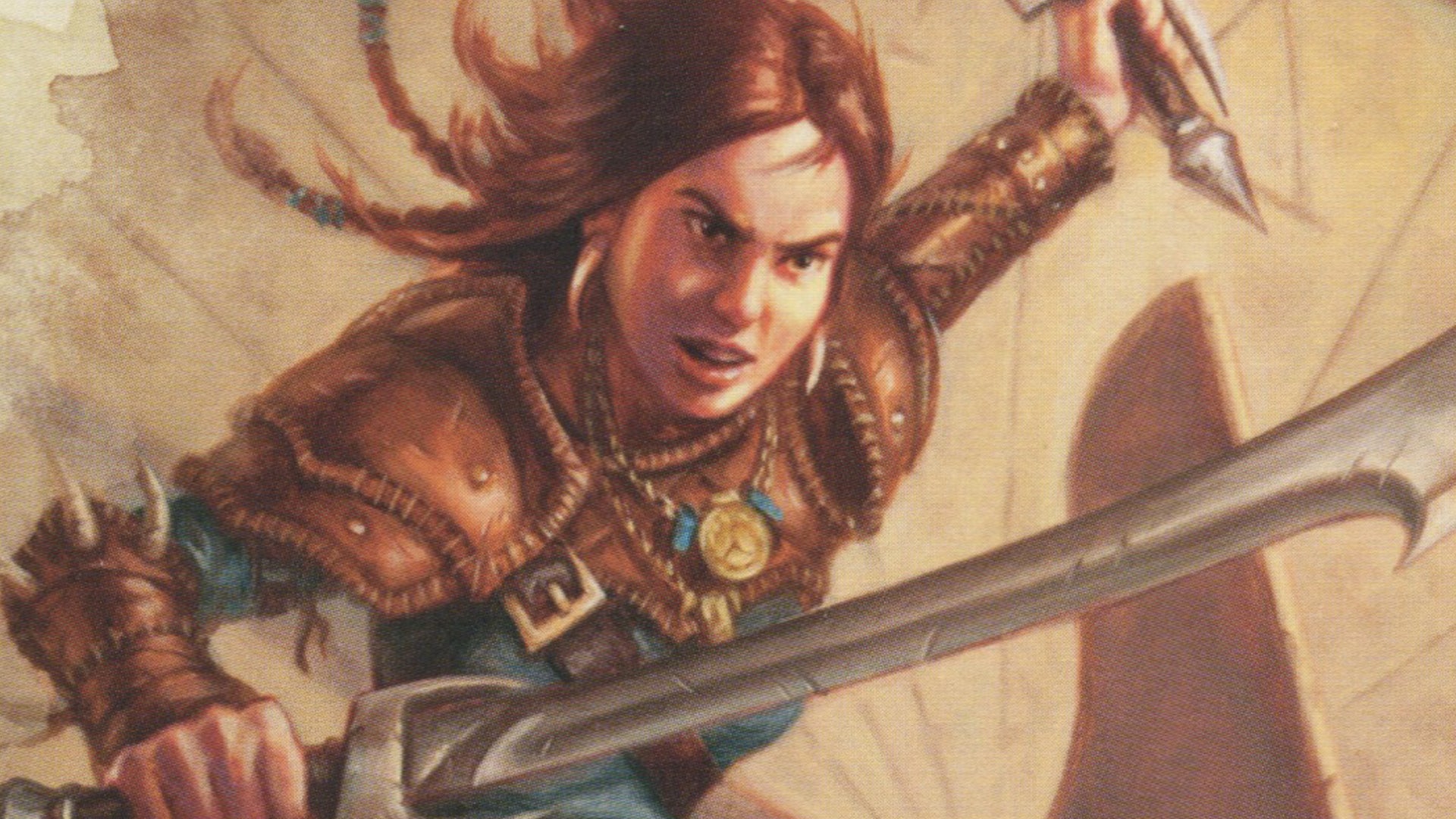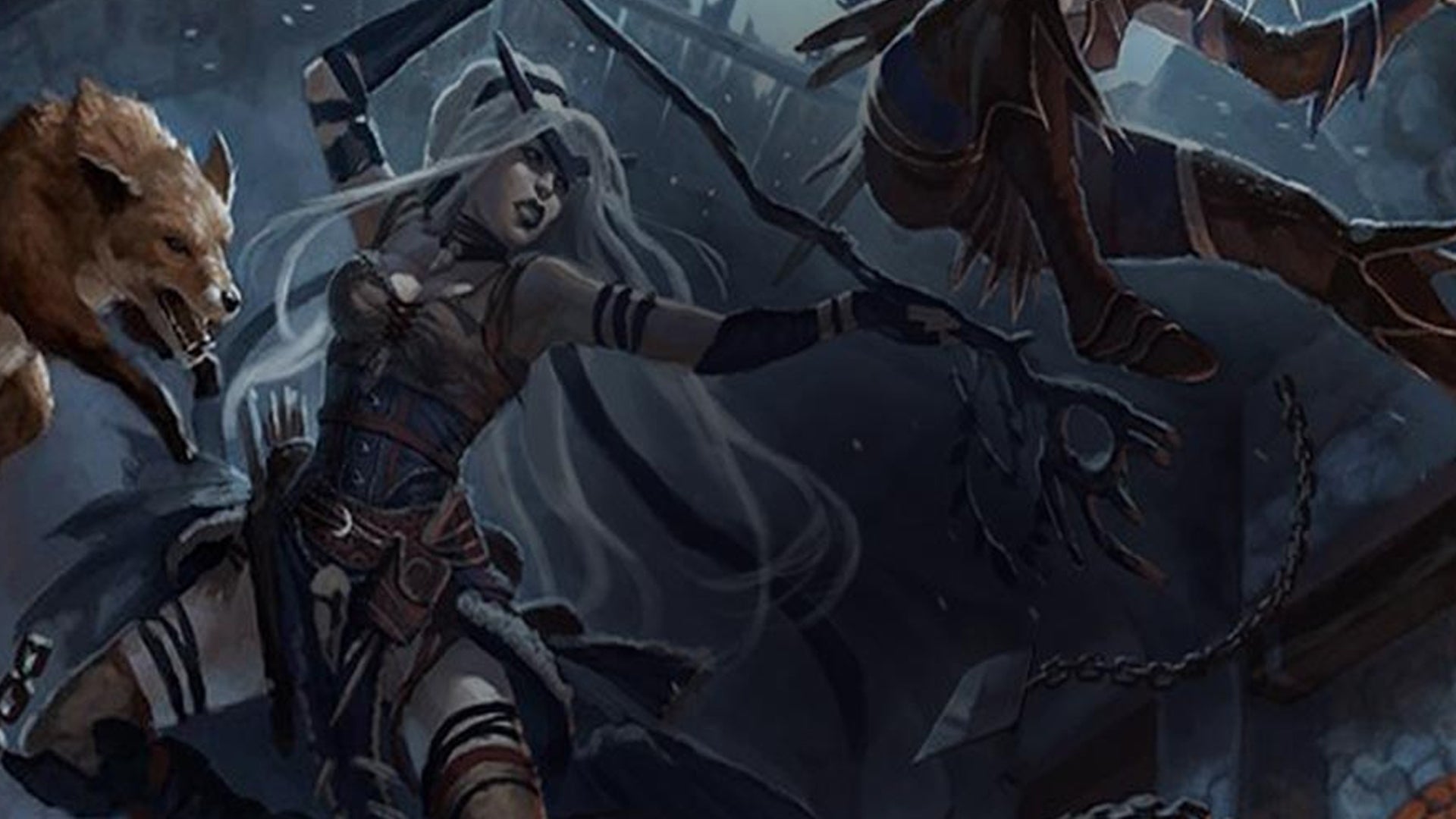5e Can a Ranger Attack Then Hide and Then Attack Again
The ranger is the Bear Grylls of any Dungeons & Dragons 5E political party. Grizzled and resourceful, capable of finding passable trails in otherwise treacherous landscapes, rangers bring a hefty amount of utility and customisation.
Rangers are an unusual type, which, when yous think most it, is something yous could say this about pretty much D&D 5E class. (Compare the options and learn how to pick your form in Dungeons & Dragons with our guide.) Simply rangers are genuinely weird when compared to their Dungeon & Dragons brethren, but considering they're both incredibly customisable and yet quite streamlined.
- Choosing ranger skills and equipment: what proficiencies to give your ranger, equally well every bit weapons and armour.
- Selecting a favoured enemy and terrain: what these unique ranger elements are and how to choose the best options for your ranger.
- How exercise rangers employ magic in Dungeons & Dragons 5E?: rangers have a very specific way of using spells, observe out how in this department.
- What is extra attack and how can rangers use it?: Extra Assail is ane of a ranger's almost useful feats - acquire more in this section.
- Using Primeval Awareness, Land'due south Stride and Hide in Patently Sight: These are the quintessential powers that define the ranger form, find out how to use them in this department.
- Selecting a ranger archetype: these are the dissimilar paths that your ranger can take to further focus their abilities, decide which one to choose here.
- The Hunter archetype: a ranger archetype that focuses on monster slaying.
- The Beast Master archetype: a ranger archetype that enables y'all to tame creatures.
- What race should I play as a ranger?: What kid of races piece of work with the ranger class and how to choose the right race in Dungeons & Dragons 5E
In concept, rangers are a scrap like Batman equally their graphic symbol is entirely based around their chosen nemeses'. This is besides what makes the ranger a particularly strange course to create, every bit they take the opportunity to choose loads of little quirks focused around whatever creature they're virtually obsessed with defeating. This may make rangers seem very limited, merely they as well go a whole smorgasbord of talents, skills and fifty-fifty spells on top of all this - which you lot can learn to use with our guide to the basics of Dungeons & Dragons.
And so enough philosophising. Permit's get into what is actually involved in making a D&D 5E ranger.
Choosing ranger skills and equipment

Despite being 1 of the more than limited Dungeons & Dragons classes when information technology comes to weapon proficiencies, rangers still get a nice mixture of equipment to cull from at first level. If the word 'proficiencies' is coming up with a blank, so nosotros recommend you have a look at our guide to Dungeons & Dragons 5E terms explained.
Before we dig our hands into the pile of ranger equipment you get to choose from, nosotros need to decide which of the showtime skills you want your grapheme to have proficiency in. Yous'll get to pick 3 skills from a list of brute handling, athletics, insight, investigation, nature, perception, stealth and survival.
Whichever y'all cull entirely depends on the flavour of ranger you're aiming to create. Are they a friend to all animal kind and a master of mother nature'south fine bounty? Then the fauna treatment and nature skills should almost definitely exist included in your chosen three. Or how nearly a ranger that confidently bounds through forests hot on the trail of some sort of rapid animal? Taking the athletics and survival skills are guaranteed to get them on the path towards this dream.
Once y'all've got your chosen proficiencies down, you tin get stuck into the ranger's starting equipment. It'south arguably one of the most well-balanced groups of equipment sets in Dungeons & Dragons 5E, with a varied mix of armour, weapons and packs. Choose between the (a) and (b) options of each prepare, with the concluding being mandatory (considering every ranger needs a longbow). What you decide on will likely be driven past which of the upcoming fighting styles you lot want your ranger to prefer, and if you lot want them to cover manoeuvrability over resilience. Other than this, yous'll be selecting between a dungeoneer'due south or explorer'due south pack, which comprise rather like items, aside from some differences in tools over comforts. If you lot plan on breaking in anywhere, then pick the dungeoneer's, otherwise the explorer's pack is probably a damn sight more than useful.
Selecting a favoured enemy and terrain
This is where the ranger weirdness really begins to boot off. You'll select what'due south known as a favoured enemy from the bachelor options on page 91 of the Dungeons & Dragons 5E Player's Handbook, which are roughly the kind of ambitious groups you lot might face throughout your journeying. Y'all'll probable find more information on each of these groups in the Player's Handbook or many of the other sourcebooks for Dungeons & Dragons 5E. Your ranger's favoured enemy tin can be decided past a number of factors, including the idea that they but hate that kind of creature (it is difficult to love an ooze). Another approach is to simply ask what setting your DM intends to run your campaign in, and do a little enquiry into what kind of creatures might dwell in such a place.
You lot tin can take a similar approach to selecting your favoured terrain with the Natural Explorer talent; either pick an environment that would likely announced in the setting of your upcoming entrada, or one that would make sense in the context of your character.

Favoured Enemy and Natural Explorer are both entirely unique to the ranger class in D&D 5E, and don't really involve any of the usual elements seen in most talents. The Favoured Enemy talent gives you advantage on wisdom power checks whenever you want to track that particular type of creature. Aslope reward on any time you desire to roll an intelligence ability check to retrieve information virtually that creature. What is advantage and what are power checks? They're key gameplay concepts featured in our guide to the nuts of Dungeons & Dragons, which should clear any potential confusion.
The Natural Explorer talent is even weirder than Favoured Enemy, equally information technology provides a wide multifariousness of full general benefits you tin can await to receive whenever you happen to come across the detail terrain you've chosen. These include not getting lost (except through magical means), finding more than nutrient whenever you lot forage, and not being slowed past difficult terrain (paradigm heavy mud and the like).
How do rangers use magic in Dungeons & Dragons 5E?
Despite not being primarily a spellcasting course, all rangers gain admission to a listing of spells at second level. These spells exist in their own subclass of ranger spells, which means that y'all will be limited to just casting spells from this list.
As rangers are not a spellcasting class, their spellcasting ability is derived direct from their wisdom ability score rather than a spellcasting ability score as information technology is with wizards, sorcerers, and the like. Ability scores are hashed out in our Dungeons & Dragons 5E character creation explained guide, so hop at that place if yous want to piece of work out what your wisdom score might exist.
You begin second level with only 2 first level ranger spells, simply this total slowly increases equally and when y'all level up.
If y'all were interested in learning more near spellcasters, then how nearly having the Dungeons & Dragons 5E wizard form explained?
What is Actress Attack and how tin can rangers utilise it?
Extra Attack is gained by rangers at fifth level, and simply put, enables them to attack twice in a single round, rather than just once. This talent can be used once per gainsay round, and can be stacked with any other spells or abilities that otherwise let your ranger to attack more than once.
If y'all want to larn more than about gainsay rounds, then have a read of our guide to the nuts of Dungeons & Dragons.

Using Primeval Awareness, Country'south Stride and Hide in Plain Sight
As your ranger continues to level-upward, they'll proceeds access to a few more neat fiddling talents to help ameliorate their tracking and stealth abilities.
The first of these is the Primal Awareness talent, which too happens to tie into your spellcasting ability. By expending one of your spell slots, your ranger will acquire a sort of sonar sense to detect whether any creatures of a sure type are in the surrounding surface area.
The 2nd of these talents is Land's Footstep, which you'll proceeds at eighth level. Land's Stride makes you lot immune to any slowing effects caused past difficult terrain and any non-magical plantlife; think tangled vines or particularly vicious thorns.
The final of these talents is Hide in Apparently Sight, which takes your ranger'southward ability to blend into their natural surround beyond the figurative. With Hide in Patently Sight, your ranger will be able to camouflage themselves using resources establish around them, Predator-style. This will give yous a +x bonus to stealth checks whenever your ranger attempts to hide in that environs.
Selecting a ranger archetype
Whereas nigh D&D 5E classes get to cull betwixt at least three different variations of their character build, rangers just go the two. At least, when it comes to the content featured in the Dungeons & Dragons 5E Player'due south Handbook. There are, of course, several ranger archetypes out at that place, including those featured in various other sourcebooks for Dungeons & Dragons 5E. Yet, for this guide we're going to stick to those options constitute in the Role player'south Handbook
.
Luckily plenty, these two archetypes are different plenty that rangers aren't really missing out by not having a 3rd option. The Hunter classic is all about expanding your ranger's existing specialisations, mainly the Favoured Enemy talent, into an even deadlier arsenal of monster-killing abilities. Whereas the Beast Master archetype takes your ranger down an entirely new road, one that involves taming powerful creatures and setting them on your enemies.
The Hunter archetype
Taking the Hunter archetype will turn your ranger into the ultimate monster slayer, with talents to significantly improve their combat capabilities.
You lot'll get your kickoff combat talent equally shortly as you take upward the classic, with the Hunter'southward Prey selection. This particular chocolate box of combat options includes a talent for each season of encounter, whether you're facing an enormous fauna, a towering giant or a swarm of minions. You'll get to choose from 3 nifty abilities, depending on which of the to a higher place encounters your ranger is well-nigh decumbent to stumbling into. We accept to say that Colossus Slayer is particularly good, as information technology can utilise to any enemy, as long as they're currently beneath their striking point maximum (significant, equally long equally they've taken damage).
Whereas, the next toolset y'all'll get to pick from is more defense-based, with nifty little talents saving you from nasty condition furnishings and attacks of opportunity. Once more, your decision is dependent upon what situations you want to give your ranger a helping hand in. Absolutely, the Multiattack Defense talent works especially well when tackling enemies with a larger puddle of hit points, as information technology gives your ranger a +4 bonus to their AC whenever you face an attack from something that's striking you on a previous occasion. (Desire to know how to calculate your Ac? Head over to our guide to Dungeons & Dragons 5E character creation explained.)
Whichever talents you lot choose side by side, will be decided by your ranger's chosen weapon and general approach to combat. If they use a ranged weapon, then take Volley; if they use a melee weapon, take Whirlwind Set on.

The Beast Master archetype
Taking the Beast Master archetype sends your ranger downwardly a completely unlike route.
Yes, that'due south right. Beast companions.
Rangers who adopt the Beast Master archetype gain the ability to tame a beast of your choosing, as long as it's no larger than medium sized and isn't college than a challenge rating of i quarter. This substantially means that your ranger gets their very own Toto-slash-Battle True cat to travel around with them, simply equally long as they don't choice annihilation too enormous or overpowered. You tin can find a lot of potential candidates for your animal companion in either the Dungeons & Dragons 5E Dungeon Master's Guide or the Dungeons & Dragons' Monster Manual, alongside their associated stats, size and difficulty rating.
What can your creature companion do as well wait really cute and crawly? Well, they essentially become another member of your D&D party; using your proficiency bonuses for their modifiers, they'll be able to take their own combat plow and perform their own deportment independently from y'all. During combat, you'll be able to command it to take one of the major deportment available to it (assault, dash, disengage or help), and even if your ranger is incapaciated or otherwise out-of-action, then your brute companion tin go along fighting.
As you level-upwards, your animal companion will gain new talents that allow information technology to attack multiple times during its plow and your plow.
What race should I play as a ranger?
Which races piece of work best for the ranger class has been lightly covered by our guide to how to choose the right character race in Dungeons & Dragons 5E, which is a slap-up resource if yous want to peruse D&D's various bachelor races. In the interests of streamlining your graphic symbol cosmos experience, we're going to embrace the subject in a little more detail here.
With their lithe frames and gentle footsteps, elves are generally a proficient shout for classes that thrive on dexterity. Benefitting from a dexterity score increase, having darkvision, and a proficiency in perception, makes elves rather perfect for skulking effectually nature's highways. This especially goes for woods elves who, with their Fleet of Foot trait and ability to hide in bad weather condition, makes them particularly manoeuvrable in natural environments.

Dexterity comes in handy over again with the halfling race, who not only become an increase to their DEX power score, merely also do good from the nimbleness trait (which allows them to motility through spaces containing larger creatures). They're also surprisingly proficient damage dealers, as they have the ability to re-roll any ones on assail rolls.
It seems that most adept things do come in small packages, every bit gnomes are also a brilliant choice of race for the ranger class. Alongside the ever-useful trait of Darkvision, gnomes also get advantage on all charisma, wisdom and intelligence saving throws, which is an especially benign when fighting against monsters that may attempt to put status effects on you. The forest gnome is a item skillful choice when creating a ranger, as they get an increase to their dexterity power score.
That's pretty much a wrap on how to create your perfect ranger, but if you lot're curious about what other classes D&D has to offer, and then you tin find everything y'all demand to know in our guide to how to choice your character class in Dungeons & Dragons 5E. Maybe you want to exist a rogue? Maybe accept a wait at our Dungeons & Dragons 5E rogue class explained. Or if you fancy making a fighter, then have a read of our guide to Dungeons & Dragons 5E fighter class explained.
Source: https://www.dicebreaker.com/games/dungeons-and-dragons-5e/how-to/ranger-class-explained
0 Response to "5e Can a Ranger Attack Then Hide and Then Attack Again"
Post a Comment